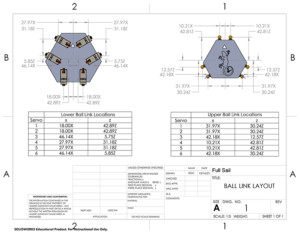Simulation & Visualization Developer
01
Services
XR Virtual
Simulations
Immersive experiences in VR and AR.
Development of digital training in real scenarios. So, safety and best practices can be learned in a more dynamic and fun environment.
Design
Improvement
Enhancement of
existing devices.
Precise scan of items to be redesigned for higher resistance, weight lighting, or material studies for better performance.
Digital Fabrication
3D Printing, laser cutting, and CNC manufacturing.
High-precision creation and assembly for the creation of hardware and electronics to add to your XR projects.
02
Who Am I
Eric Goya
Studies
Bachelor in Simulation
& Visualization Engineer
Recently graduated from Full Sail University. My specialization is in C# and C++ programming, 3D modeling, and prototyping in CAD software, and high knowledge of game engines such as Unity and Unreal.
03
Portfolio
Projects
*
XR Virtual Simulations
Davinci VR training
3D Max design, rigging and Unity Game Engine.
Surgical robot training.
Adventhealth requested a simulation to train the technicians on how to set up the Davinci before the doctor begins the process.
On this occasion, the team had to do deep research on this highly precise robot. We all went to a regular training session to be able to understand the process, the problems that regular trainees have, and the requirements that have to be fulfilled.
This simulation goes into how to insert the cannulas in the patient, how you can move the robot depending on where you grab it or which button you press, and how to use the inserted camera to not put at risk the patient when you are doing this process.
In this case, I was in charge of modifying the model to be able to do the animations needed and all the inverse kinematics to replicate the movement of the arms of the robot.
*
Digital
Fabrication
Stewart platform
CAD design, modeling, and motion study in SolidWorks.
6DOF platform assembled and connected to a Dog sled simulation.
In this project, I created from scratch a fully functional Stewart Platform.
The modeling has been made in SolidWorks and also the motion study for getting the range of the servos. After that, I 3D printed the base and the top surface, and laser cut the mid plate. For the controls of the servos, I designed a circuit board in Eagle and soldered it in an Arduino microcontroller.
This platform was then connected to a Dog sled simulation that I have developed in unity with an external controller for the sled that has been built in a stuffed husky.
*
Design
Improvement
Backrest of a wheelchair
CAD design, modeling, and simulation study in SolidWorks.
3D printed lighter backrest.
For this project, I was given an existing backrest of a wheelchair made of titanium. This backrest was too heavy for the client to be lifted with one hand from the back sit of the car. So, my mission was to make it lighter.
In this location, I laser scanned the original backrest to keep the exact dimensions so the gadgets and anchor points will be located in the same spots. Once the scan was finished I redesigned it in SolidWorks to take out the excess material and developed several structure simulations to be able to be printed and have enough resistance for a human resting on it. The major challenge was to have enough resistance being a plastic piece and to not have any deviation from the original scan. This weight cut has come from 950 g. to 390g.
*
Digital
Fabrication
F1 3D printed replica of Red Bull Car
CAD design, modeling, manufacturing and electronics.
F1 Simulator.
This has been a group project where we have to create a full-size F1 replica. The challenge in this project is the scale. First, we had to create several pieces to be printed because we didn’t have access to a 3D printer big enough. After this, we study the joints so when the F1 car is assembled there are no big deviations from the original design. To create more strength the interior of the car has been covered with fiberglass and ribbed.
To be able to use it in a simulator several Arduino has been installed to control the cameras, lights, fans, belts, and drives.
My role in this project has been the reinforcement in fiberglass and the programming of the Arduino to read the input of the simulation and communicate with the lights and fans of the vehicle.

